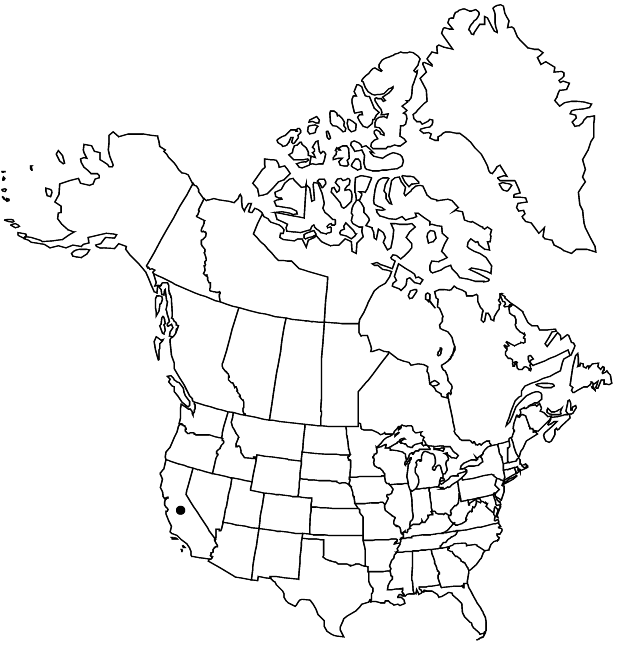Difference between revisions of "Arctostaphylos glutinosa"
Amer. Midl. Naturalist 23: 620, plate 1, fig. 2. 1940 ,.
FNA>Volume Importer |
imported>Volume Importer |
||
| (6 intermediate revisions by 2 users not shown) | |||
| Line 7: | Line 7: | ||
}} | }} | ||
|common_names=Schreiber’s manzanita | |common_names=Schreiber’s manzanita | ||
| + | |special_status={{Treatment/ID/Special_status | ||
| + | |code=E | ||
| + | |label=Endemic | ||
| + | }}{{Treatment/ID/Special_status | ||
| + | |code=C | ||
| + | |label=Conservation concern | ||
| + | }} | ||
|basionyms= | |basionyms= | ||
|synonyms= | |synonyms= | ||
| Line 24: | Line 31: | ||
|distribution=Calif. | |distribution=Calif. | ||
|discussion=<p>Of conservation concern.</p><!-- | |discussion=<p>Of conservation concern.</p><!-- | ||
| − | --><p>Arctostaphylos glutinosa is found in chaparral and knobcone pine woodlands on Monterey Shale barrens near the Pacific Coast in a limited area of the central Santa Cruz Mountains on northern Ben Lomond Mountain in Santa Cruz County.</p> | + | --><p><i>Arctostaphylos glutinosa</i> is found in chaparral and knobcone pine woodlands on Monterey Shale barrens near the Pacific Coast in a limited area of the central Santa Cruz Mountains on northern Ben Lomond Mountain in Santa Cruz County.</p> |
|tables= | |tables= | ||
|references= | |references= | ||
| Line 33: | Line 40: | ||
-->{{#Taxon: | -->{{#Taxon: | ||
name=Arctostaphylos glutinosa | name=Arctostaphylos glutinosa | ||
| − | |||
|authority=B. Schreiber | |authority=B. Schreiber | ||
|rank=species | |rank=species | ||
| Line 47: | Line 53: | ||
|publication title=Amer. Midl. Naturalist | |publication title=Amer. Midl. Naturalist | ||
|publication year= | |publication year= | ||
| − | |special status= | + | |special status=Endemic;Conservation concern |
| − | |source xml=https:// | + | |source xml=https://bitbucket.org/aafc-mbb/fna-data-curation/src/2e0870ddd59836b60bcf96646a41e87ea5a5943a/coarse_grained_fna_xml/V8/V8_824.xml |
|subfamily=Ericaceae subfam. Arbutoideae | |subfamily=Ericaceae subfam. Arbutoideae | ||
|genus=Arctostaphylos | |genus=Arctostaphylos | ||
Latest revision as of 22:46, 5 November 2020
Shrubs, erect, 1–2 m; burl absent; twigs sparsely to densely soft-hairy with some glandular hairs. Leaves: petiole to 4 mm; blade glaucous, dull, oblong to oblong-ovate, 2–5 × 1–3 cm, base distinctly lobed, auriculate-clasping, margins entire, plane, surfaces smooth, gray-canescent, glabrescent. Inflorescences panicles, 2–4-branched; immature inflorescence pendent, branches spreading, curved, (obscured by bracts), axis 1.5–2.5 cm, 1+ mm diam., sparsely to densely soft-hairy with glandular hairs; bracts not appressed, leaflike, oblong-lanceolate, 5–15 mm, apex acute, surfaces canescent. Pedicels 5–8 mm, finely glandular-hairy. Flowers: corolla white, urceolate; ovary densely long white-hairy, hairs often gland-tipped. Fruits depressed-globose, 7–14 mm diam., glandular-hairy, (viscid). Stones distinct. 2n = 26.
Phenology: Flowering winter–early spring.
Habitat: Chaparral, closed-cone conifer forests
Elevation: 500- 700 m
Discussion
Of conservation concern.
Arctostaphylos glutinosa is found in chaparral and knobcone pine woodlands on Monterey Shale barrens near the Pacific Coast in a limited area of the central Santa Cruz Mountains on northern Ben Lomond Mountain in Santa Cruz County.
Selected References
None.
